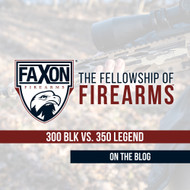300 Blackout vs. 350 Legend: Which is Better?
Posted by Faxon Firearms Staff on Aug 16th 2022
Why Compare .300 Blackout vs .350 Legend?
Whenever a new cartridge comes out, there’s always an immediate debate in the firearms community about how it compares to existing cartridges. In the case of the recently-released .350 Legend, the comparisons to .300 Blackout came thick and fast after it debuted in 2019.
Let’s take a look at how these two rounds stack up ballistically, what makes them so easy to compare, what makes them different, and how to choose the best one for your intended purpose.
Cartridge Specs
First things first, let’s take a look at some basic cartridge specs and how they differ between these two rounds. While the stats on paper never tell the whole story when it comes to any cartridge, they do give us a good background and basis for comparison.
| .300 ACC Blackout | .350 Legend | |
| Parent Casing | .300 Whisper | .350 Legend (Unique Casing) |
| Case Length | 1.368" | 1.71" |
| Overall Length | 2.26" | 2.25" |
| Rim Diameter | .378" | .378" |
| Bullet Diameter | .308" | .357"-.003" |
| Neck Diameter | .334" | .378" |
| Base Diameter | .367" | .390" |
| Case Capacity | 26.5gr | 36.5gr |
| Max Pressure (SAAMI Spec) | 55.000 psi | 55.000 psi |
The first thing you’ll notice here is that these rounds are fairly similar, though the case dimensions vary quite a bit. That’s because while the .300 Blackout is a bottleneck cartridge, the .350 Legend cartridge is straight-walled.
That cartridge difference is the main reason the .350 Legend exists in the first place. Certain states only allow hunting with straight-walled cartridges of a certain caliber. If you’re in Michigan, Ohio, Iowa, or Indiana (or any other jurisdiction with a similar law) .350 Legend was made for you to hunt with.
The other thing you’ll notice is that these rounds both have the same rim diameter, which is coincidentally the same rim diameter as the popular .223/5.56x45mm cartridge. This is because both rounds were designed to be used with the AR-15 platform while only requiring a barrel swap.
There’s also a bit of weirdness in the official spec for the bullet diameter of the .350 legend. That .357”-.003” designation is a nod to straight-walled hunting states that require a bullet diameter of at least .357”, which you can load safely and comfortably in a .350 Legend, which is reflected in the official spec.
The -.003” part is because Winchester actually recommends loading a .355” bullet, also known as a 9mm bullet.
This would be technically insufficient according to those laws, but because the cartridge specs are listed the way they are, as far as the game warden is concerned, .350 Legend is just fine in these states (make sure to check with your jurisdiction on this as laws change and we don’t provide legal advice).
Finally, the case capacity is 37.7% higher in the .350 Legend because of that straight-walled design giving it more space for the powder charge.
Muzzle Velocity & Kinetic Energy
That extra powder gives the .350 Legend a leg up when it comes to both muzzle velocity and kinetic energy. Out of the same length barrel and firing the same 150-grain bullet, the .350 Legend will have a muzzle velocity of 2,325fps and muzzle energy of 1,800ft-lbs.
Conversely, the .300 Blackout with the same barrel length and bullet weight will have a lower muzzle velocity of 1,900fps and 1,200ft-lbs of muzzle energy.
The extra powder clearly makes .350 Legend the winner in terms of velocity and energy, though both have proven to be effective deer cartridges. How does that impact the recoil of the .350 Legend though?
Recoil
In terms of recoil, these rounds actually have very similar results.
With the same weight rifle, and using the eight most popular supersonic loadings available on LuckyGunner.com, we see that the .300 Blackout has an average recoil impulse of around 6ft-lbs. This is about 33% more than a standard .223 Remington in the same AR-15.
The .350 Legend clocks in at just over 8ft-lbs of recoil energy from the same rifle set up, or around double what you’d feel with the .223 AR.
Realistically, neither of these rounds is particularly punishing to shoot, but it is worth noting that the .350 Legend does recoil a good bit more than the .300 Blackout. It’s not going to beat your shoulder up, but it can make rapid follow-up shots more difficult as it’ll be slower to get back on target.
How much does that matter in a hunting scenario? Probably not much unless you’re blasting away at feral hogs, nor will it make a difference in a personal protection scenario. Still, worth noting and keeping in mind for the .350 Legend vs .300 Blackout comparison.
Trajectory & Terminal Ballistics
When it comes to the actual trajectory of these two rounds, or how they travel through the air and perform at range, simple physics is on the side of the .350 Legend and makes it the pretty clear winner.
That extra powder of the .350 Legend makes it a flatter-shooting round that will have less drop at range. The .350 Legend has an effective range for deer hunting out to about 250 yards, while the .300 Blackout is really only effective to about 170 yards with most loadings.
The .300 Blackout does have a better ballistic coefficient due to the spitzer-style bullet, meaning it will have less drift due to wind, but practically, this doesn’t come into effect since both rounds are designed to be used at relatively short ranges where the wind isn’t really a factor.
For strictly putting holes in paper, .300 Blackout would probably be easier to use simply because it’s much easier to compensate for vertical drop than it is horizontal drift (the latter is something precision shooters will spend a lifetime on), but for real-world use, the .350 Legend is clearly superior downrange.
Practical Applications
Hunting
For hunters, the .350 Legend has to be the obvious winner here. The round was designed for sporting use in straight-walled-limited states, but it excels at putting deer-sized game down in any jurisdiction. It has greater sectional density, more energy, and a flatter trajectory.
That said, .300 BLK is still an effective deer cartridge, especially in areas where shots don’t exceed 200 yards or so. At the end of the day though, a tool built for the job is going to perform better than one that isn’t, and the .350 Legend was designed with hunting in mind first and foremost.
Suppressor Use
When it comes to suppressed use, we have a clear-cut winner, and that’s the .300 Blackout. At the end of the day, one of the design goals for the .300 Blackout was complete powder burn in a 9” barrel.
That means you can run a shorter barrel AR, either a pistol or a true SBR, and slap a suppressor on it and your overall barrel length will be under 16” even with the suppressor and you’ll lose basically no velocity.
This has made the .300 BLK very possible with SBR/AR pistol owners, and one of the most popularly-suppressed rounds in the industry. While the .350 Legend has some excellent subsonic ammo out there, the round itself just wasn’t designed around quite the same parameters so the .300 Blackout takes the win here.
Self-Defense
In terms of self-defense/home-defense, we have to give the win to the .300 Blackout again here. Both rounds will get the job done, but .300 Blackout was designed for close-quarters combat.
Will .350 Legend work? Certainly. Put us on record as officially not wanting to get shot with either of these rounds. That said, the .300 Blackout fits into standard AR platform mags, has less recoil, has greater magazine capacity, and works better with a short barrel.
All of that combines to make it superior in almost all self-defense scenarios, unless you have to shoot something 200m away, which is almost unheard of in a true self-defense scenario, practically speaking.
Price & Availability
When it comes to price and availability, the .300 Blackout takes the cake. It’s a smaller cartridge, bullet, and case, and it uses less powder. It’s also been out longer and has become one of the most popular non-.223 AR-15 calibers.
The simple economics of having a smaller, more popular, cartridge means the .300 BLK is cheaper and more widely available. That said, it isn’t that much cheaper, surprisingly. You’re looking at a 5-10% price difference for similarly-loaded offerings, which isn’t bad.
For sheer variety of loadings available, .300 Blackout wins this one.
Final Thoughts
At the end of the day, both .300 Blackout and .350 Legend are great cartridges with proven track records. As with most caliber comparisons where the rounds are reasonably close like this, the difference comes down to shooter preference, and what exactly you plan on doing with it.
For sheer energy and penetration, the .350 Legend takes the cake here. For smoothness of shooting, suppressed use, and cost/availability, .300 Blackout is the winner. Both are great, and since you only need a barrel swap to use both, why not just have both?
Speaking of barrels…
The Faxon Difference: Our .300 Blackout and .350 Legend Barrel Offerings
Faxon manufactures each one of our barrels to the highest standards, and we offer a variety of barrels for both .300 Blackout and .350 Legend.
Our .300 Blackout offerings include our Gunner profile barrels as well as our Match Series barrels in lengths from 6” AR-15 pistol offerings up to full-length 16” rifle barrels. Our .350 Legend barrels are available in Gunner profile, and come in 12.5”, 16”, and 20” varieties.
All of our barrels are manufactured in-house in our Cincinnati facility and are fully stress relieved, air gauge tested, and target crowned for accuracy. They are then hand-checked for headspacing so they can drop right into your existing rifle, or your next rifle build.

